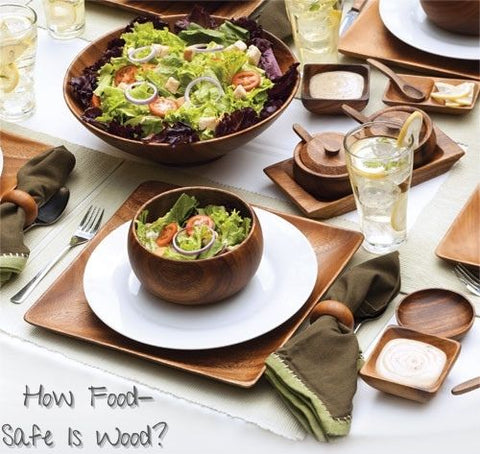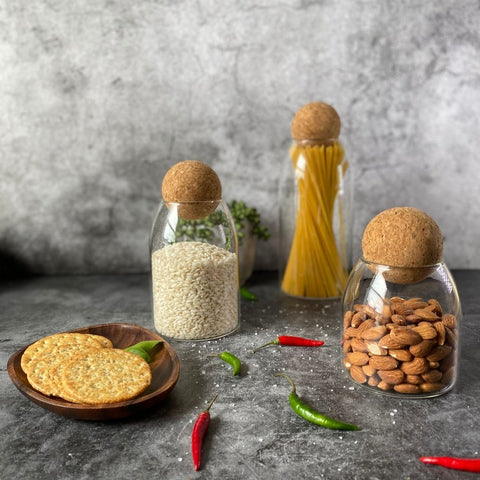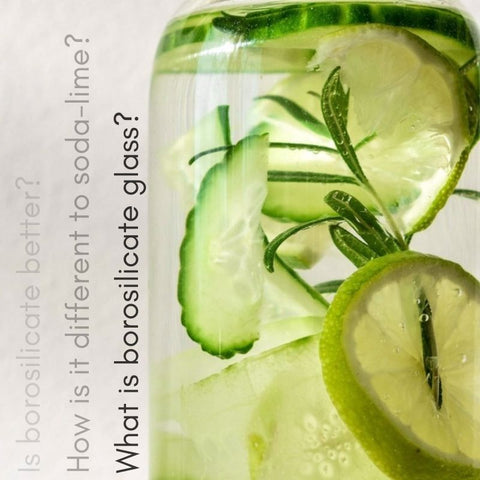
Is Wood Itself Food-Safe?
As a raw natural material, the vast majority of wood is 100% food-safe - the exceptions being a few species of poisonous trees, which are not used for kitchenware and generally not used for their wood at all.
-
Most of the time, the question of wood being food-safe actually depends on which type of oil is used to seal the wood.
- Wooden kitchenware is usually sealed with a natural and/or food-safe oil, but it’s always a good idea to double-check before you buy.
So, in short, yes, wooden kitchenware is food-safe but there are some things you need to look out for, which we'll go into below.
There have even been many studies showing that wood is actually a safer choice than plastic for food-related items such as chopping boards.
The Science Behind Wood Kitchenware's Food Safety:
One of these studies was done by Dr Dean Cliver, Professor of Food Safety at the University of California.
Carried out over a few weeks, Dr Cliver discovered that bacteria survived and thrived for much longer on a plastic cutting board, while the same bacteria did not survive long on the wooden board, which was also used alongside the plastic one for the same period of time.
Photo by: Elle Collins featuring Black Walnut Serving Boards
What are the benefits of wooden kitchenware?
- Wood is a natural, renewable and biodegradable material.
- There is little-to-no risk of dangerous chemicals, as with some plastics, pottery coatings and metals.
- It’s easy to care for and to repair by yourself.
- It’s naturally antibacterial and anti-fungal.
- Wood insulates hot or cold food & drinks.
- It’s strong, flexible and doesn’t shatter or smash, making it child-friendly.
- It's desired for the individuality of colouration and patterns.
- Many enjoy the pleasant tactile experience of wood.
Photo by: Patrycja Lewczyk featuring Round Acacia Plates
What Makes Wood Food-Safe?
As mentioned above, the vast majority of natural, unprocessed wood is 100% food-safe. The question of food safety normally depends on which oil is used to seal the wood. Food-safe wood sealants include any natural oils (linseed, coconut, acacia, walnut, olive) and some synthetic sealants and other lacquers.
Many species of hardwood trees such as acacia and walnut have naturally-occuring oils that are anti-bacterial and anti-fungal.
These oils stay embedded in the wood long after the tree has turned into a piece of kitchenware, and will act as a barrier of protection against water. They also help stop anything growing on the wood surface, whether it's a tree or a wood bowl.
The Downsides of Wooden Kitchenware & Tableware:
- Depending on how much you use it, wooden kitchenware will require some love and care if you want it to keep it looking as shiny and vibrant as they day you got it, so in this way it's not as convenient as some other materials such as porcelain.
- Wood can absorb some stronger stains and odours over time (see below), this depends on how dense the wood is, and how well sealed it is - which is why it's important to re-oil items that get used the most. But, this way you also develop more appreciation for the tools and objects you use - if slow-living is your thing.
- Wood is not as cheap to produce as plastic or ceramic, this is because it is a natural material that has to grow from the earth and be taken care of for years. It also often requires skilled craftspeople, as it cannot be manufactured into a mould.
Care & Tips For Wood & Food-Safety:
Good Habits Make For Food-Safety
- When possible, wash by hand with warm water and soap after every use.
- Allow to dry completely before storing or reusing.
- Avoid letting the wood chip or crack. Repair any damaged parts.
- Apply oil on a yearly (or so) basis to keep the wood in top condition.
Read the wooden kithenware care guide here.
It’s generally a good idea to only wash wooden kitchenware by hand and allow them to air-dry completely before storing.
Ideally, you should apply natural oil or sealant every 6-18 months, depending on how much you use them. This will help the colour and vibrancy to remain strong for many years to come. If cared for, wood can last for decades or even lifetimes.
Also try to avoid letting the wood get damaged, cracked or split. If this happens, bacteria can temporarily grow in the open area. If cracks or splits appear, it's best to sand and/or seal the area with some food-safe sealant or oil.
Healthy lunch table setting with Square Acacia Plates & Acacia Nesting Bowls
Can You Put Wood in the Dishwasher, Microwave or Oven?
We have another post entirely designed to guide you through caring for all wooden kitchenware. In short, it’s usually not recommended to put wooden kitchenware in the dishwasher or microwave unless on a low heat and time setting.
Dishwasher:
You can put wooden dishes or boards in the dishwasher if you're in a pinch - or to get rid of a tough stain, but again you want to watch out for both the heat and time settings.
Keep them both to a minimum setting (sub-60 degrees C, sub-60 mins). For longevity, it’s always best to wash your wooden dishes by hand with warm soapy water and either wipe with a tea-towel or let them air-dry naturally.
Microwave:
It’s usually ok to put wood in the microwave, but again make sure it's on a low time and heat setting. We also recommend that you check on any microwaving wood every 30-40 seconds to make sure nothing unusual is going on.
Oven:
If you put wood in the oven, make sure that the temperature is not above about 40-50 degrees Celsius or you risk the wood going on fire..! Always keep an eye on any wooden items in the oven. As a rule of thumb, try to avoid any wooden items from having the pleasure of meeting your oven in the first place.

Closeup of our Fig Tree Teacup Set
What About Stains & Smells?
Again, you can read more on these topics in our full wooden kitchenware care guide.
We will just mention here that you can prevent most stains and smells by making sure the wood is well sealed (oiled) and washed after use (before stains or odours can be absorbed) and if worse comes to worst, you can always sand-out a stain or odour from the surface of the wood, and reseal the area.
Wood Surfaces & Candles:*
Wood and candles is another area, similar to the oven, that we should all try and avoid.. we don't need to tell you that any naked flame or intense heat-source is generally bad news for wood!
If you really can't resist the aesthetic, or you just happen to love the risk-factor -you can place most candles onto, for example, a wooden plate or coaster as long as you put it in a place where you can keep a direct eye on it.
Spooky setup with our Cork & Glass Tapered Jars
Of course, please use your own judgement and remember that small night lights or tea lights that have aluminium casings can get hot and have been known to burn a wood surface or two!
* Disclaimer: This is for educational/entertainment purposes only and should not be taken as fire-safety advice. Always use your own judgement and exercise caution when using wood near any sources of heat and/or fire.
Wood Vs the Rest: Plastic, Pottery & Metal Kitchenware:
Whether you should choose wood for your table and kitchen accessory collection depends on your needs, preferences and use-cases.
So, the best thing is to take all of the information we've given you here today and think about what you want from your kitchen utensils and dishes, then you will have a better idea of which items you want in wood, which ones metal, or porcelain and so on.
Wood is a clean, renewable, biodegradable material. It has no toxins to risk ingesting (plastic and ceramic coatings can leach toxins or small fragments can be ingested).
Wood is also a quiet material to use, it makes for a pleasant sensory experience when you handle it and it won’t easily chip or shatter if a child happens to throw their wooden bowl across the room. - making it child-friendly.
Minimalist layout showing the various shapes of the Gather Platters
The Wood-Factor
Wood has that certain quality and set of characteristics that make it very versatile. Of course, we all know wood is beautiful, but did you know that its beauty has a use beyond just your own appreciation?
That means that wooden utensils, boards and dishes also make great pieces for entertaining or hosting gatherings with food, wonderful frames or props for food photography, for chefs, recipe bloggers and other content creators, as well as for use as secondary props in product photography... or, just 'plain-old' decoration if you don't want to actually use them for food.
Wood Kitchenware Food-Safety: Conclusion
Wood is recorded as being used for kitchenware and food-related utensils since as early as the Iron Age (probably much earlier), and let's just say that people wouldn't still be using wood on, under, and in their food for thousands of years if it was unsafe or posed any threat to health.
Hopefully by now, you have it confirmed that wooden kitchenware is entirely safe to use with all kinds of foods and drinks. However, remember to always check what oil (if any) was used to seal the wood, and to take proper care of your wooden items between uses and they will last you for many years, for many meals and drinks!
Shop:
Read:
- Wooden Kitchenware Care-Guide
- Acacia - The Wonder Wood
- Everything You Need To Know About Black Walnut
- Seasonal Tablescapes & Centrepiece Ideas










Comments (0)
There are no comments for this article. Be the first one to leave a message!